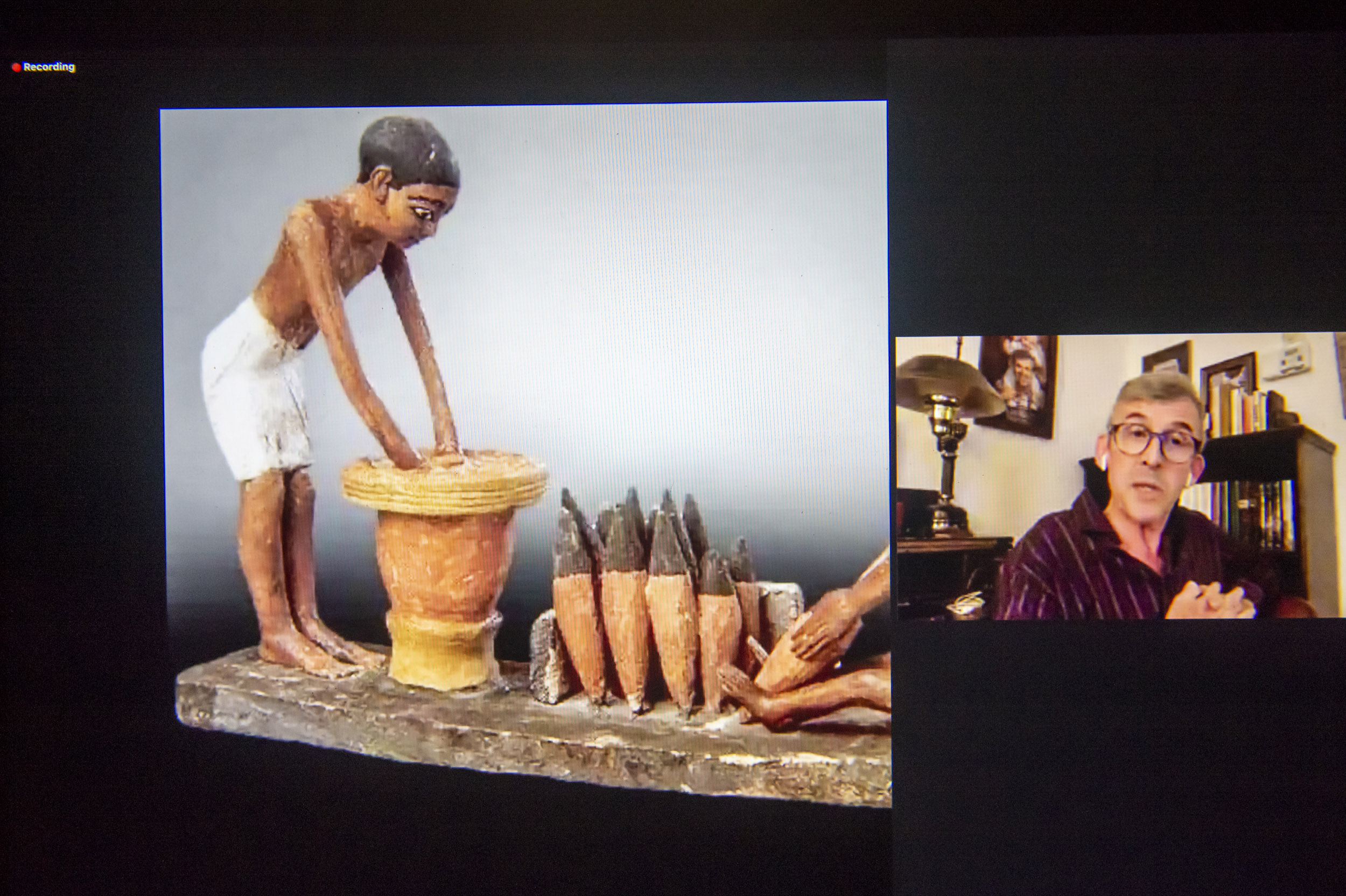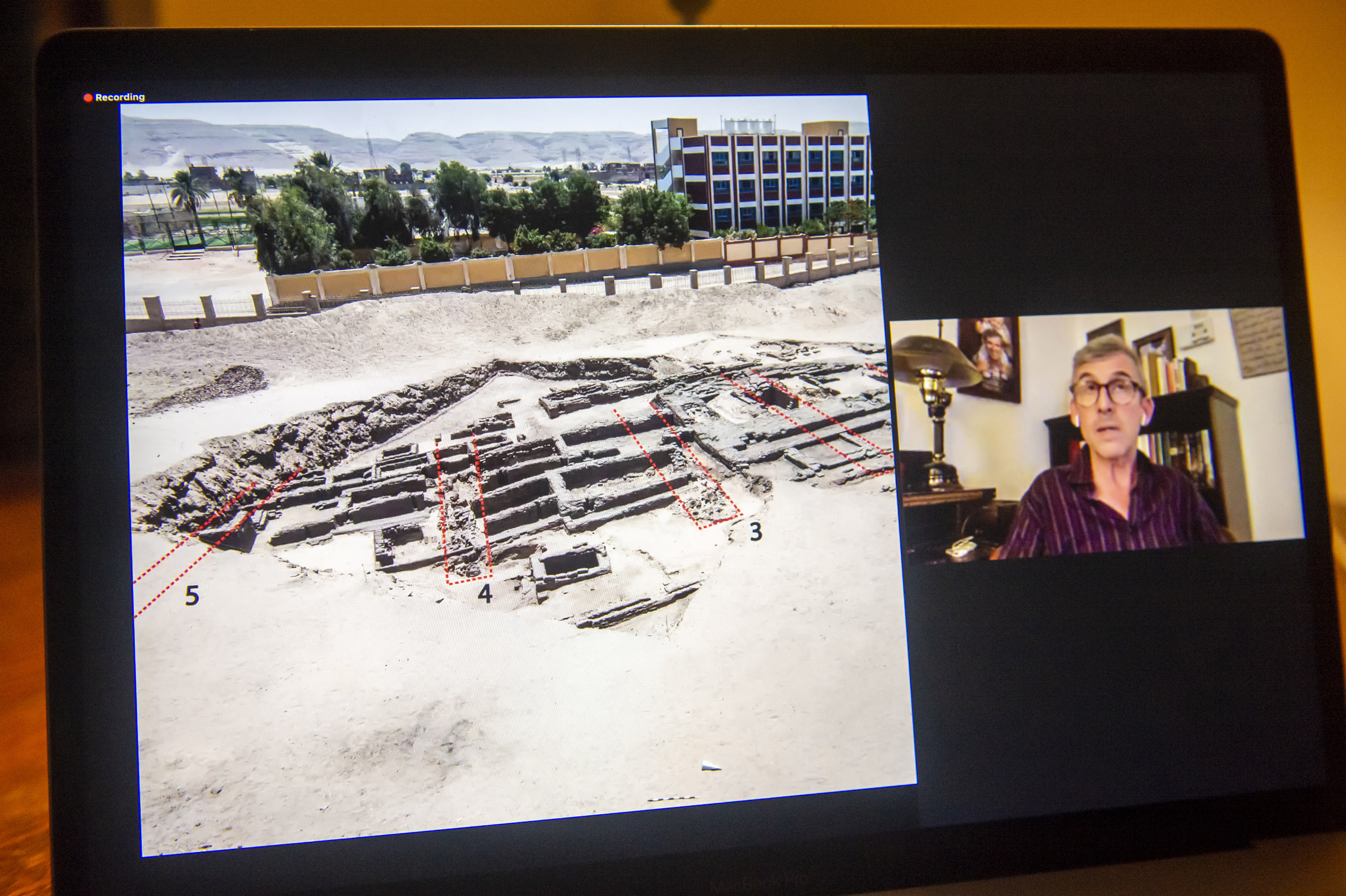
The remains of a 5000-year-old brewery found in the ancient Egyptian city of Abydos are providing insights into the relationship between large-scale beer production and the development of kingship in Egypt.
Photos by Jon Chase/Harvard Staff Photographer
Brewery fit for a king
Excavation unearths largest ancient Egyptian facility ever found, one whose industrial scale hints at monarch’s power
Matthew Douglas Adams wants to taste 5,000-year-old beer — or at least one made like they did then.
Thanks to his recent excavation of a brewery in the ancient Egyptian city of Abydos, the senior research scholar at New York University’s Institute of Fine Arts may get his wish, and soon. But the excavation revealed far more than a way to reconstruct an ancient recipe for suds. The industrial-scale production — on par with today’s best microbreweries — offers direct evidence of the kind of power wielded by Egyptian kings.
“If one batch was made each week, that’s well over a million liters a year, which is almost mind-boggling, especially in ancient terms,” said Adams in a Thursday evening lecture titled “How Beer Made Kings in Early Egypt.” The talk was part of the Harvard Museums of Science and Culture’s free, virtual, public lecture series and was Adams’ first public talk about his findings.
In previous digs, archaeologists have unearthed several breweries across various sites. But the one in Abydos is the largest so far. In the early 1900s, Egyptologist Thomas Eric Peet was excavating cemetery fields in Abydos when he found surprising remains underneath the tombs: large pottery vats, propped up by fired-mud bricks. Peet speculated the rigs were used to dry grain.
He was close. But it was Adams and his team who determined what they were really for. In two excavations during 2018 and 2020, they uncovered six large, rectangular buildings, each more than 20 yards long and three feet deep, housing about 40 vats apiece. Each vat was wrapped in mud for insulation; charcoal lay underneath; and inside, an organic residue remained, burned black and hard.
“Enough survives for us to gain a very solid picture of what was going on,” said Adams, which is to say beer production on an industrial scale.
Two similar ancient Egyptian breweries — Tell el Farkha and HK24B — could produce batches of up to about 165 gallons and 265 gallons, respectively. (A typical U.S. keg is about 15.5 gallons.) The Abydos site, built a couple of centuries later, could put out more than 5,917 gallons per batch. That’s enough to serve a pint to every person in a packed Fenway Park and a second round for about half.
“It’s an incredible amount of beer,” especially for a society at such an early stage of economic and political development, Adams said. “Why would kings or anyone at this time need this amount of beer? What would they have possibly been using it for?”
The remains of the brewery, explained by Matthew Adams.

The answer was entombed nearby. All around the brewery, Adams and his team of archaeologists discovered several royal monuments from the same era. “They would have been highly visible, painted white, and each one would have represented monumentality for each king: royal presence, royal power being materialized in this landscape.”
Inside the 107,640-square-foot monuments were chapels and, immediately outside the doorway, graveyards of thousands of ancient beer jars — tapered pottery bottles stoppered with mud. The team also found seal impressions — used on documents, beer containers, and more with the name of the king for whom the monument was built — as well as evidence of both bovine and human sacrifice.
Around each king’s monument, the archaeologists discovered tombs with precious goods, like ivory arrow points and jewelry made with rare royal purple and gold-streaked lapis lazuli. One tomb held “six very-well-cared for donkeys,” said Adams; “boat graves” held wooden vessels entombed in mud brick; and around King Djer’s tomb, they found 330 subsidiary graves, suggesting the king sacrificed nearly 600 subjects to accompany him into the afterlife.
“I cannot understand a bigger statement of a king’s power manifest,” said Adams.
The beer was another symbol of that power: Abydos’ mass production required hundreds of people to not only brew the batches but grow, harvest, and transport grain, lug water and wood to the breweries, and make the pottery vats and tens of thousands of bottles. Such widescale organization and control shows the vast command of early Egyptian kings — the first leaders of the first politically unified societies. Whether these activities, including industrial beer production, ceremonial rituals with human sacrifice, and lavish tombs, resulted from or helped establish that power is still unclear. Either way, the events defined ancient Egyptian kingship.
“Beer was one of the most important things to emerge in the evolution of human society and still has a very important place in modern society,” said Adams.
Next, he plans to enlist a biochemist to determine what recipe the Abydos Egyptians used and how they cooked their brew, which, Adams speculated, was likely less carbonated, sweeter (flavored with fruit), more alcoholic, and cloudier than modern beer. Once he has the recipe, he plans to reproduce it.
“I hope to answer this from my own experience not too long in the future.”







